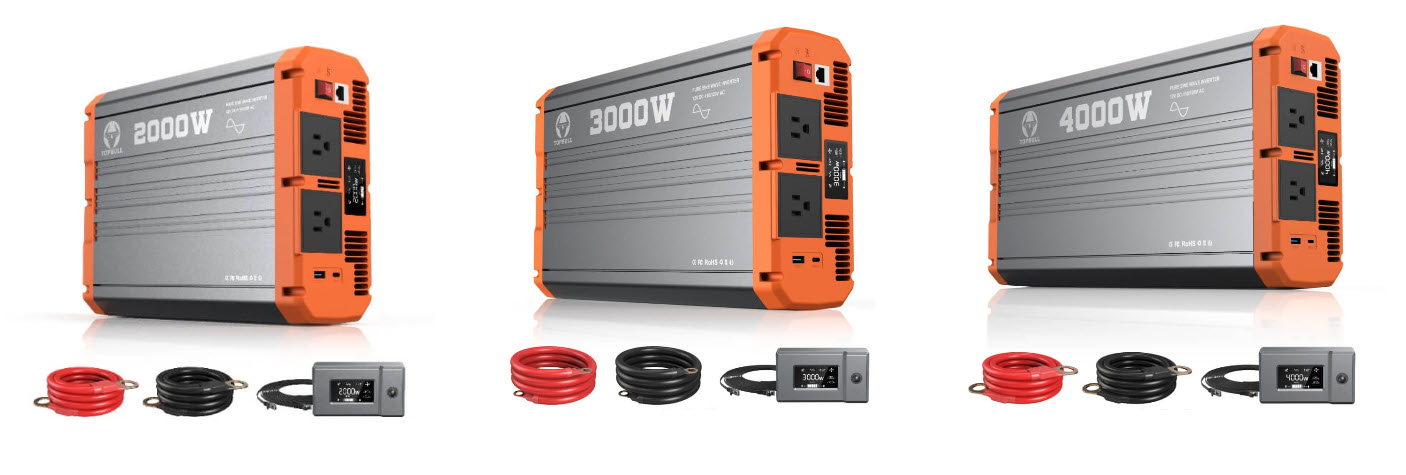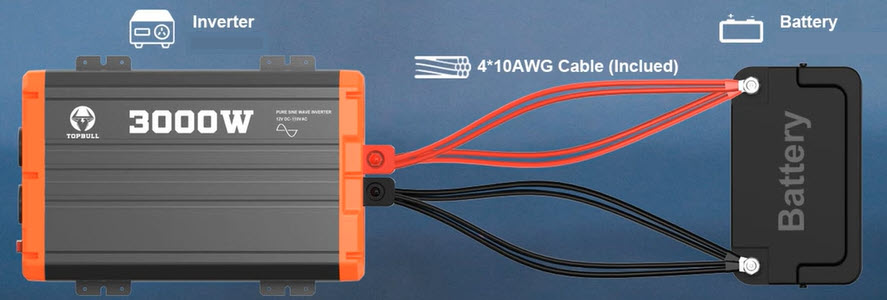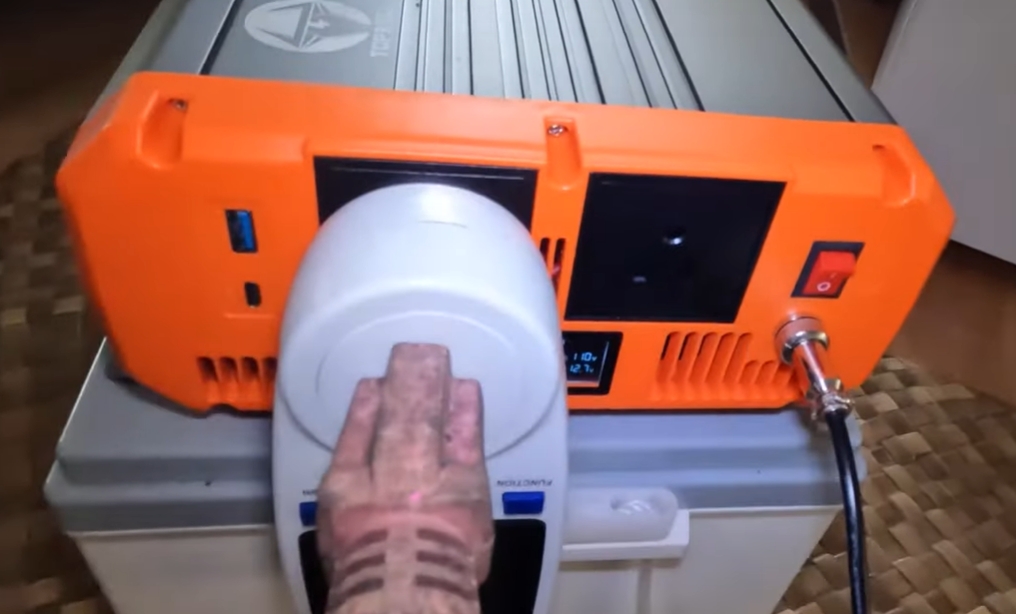Truck drivers know the struggle: long hauls without reliable power for phones, laptops, or mini-fridges. A TopBull power inverter solves this. Charge gadgets, run appliances, or even power a coffee maker right in your cab. No more dead batteries or hunting for outlets. But here's the catch: most drivers find installing one daunting because it feels complicated. What wires do I need? How do I connect it without frying my truck's battery?
Don't let confusion stall your upgrade. In this post, we'll walk you through installing a TopBull inverter, from prepping the right tools (Spoiler: it's simpler than you think) to securing connections safely. Say goodbye to guesswork and hello to hassle-free power on the road. Let's get started!
Preparations: Get Everything Ready
Before diving into installation, proper preparation is key to ensure your power system runs safely and efficiently. Here's what you need to know.
1. A Suitable Power Inverter
When selecting a power inverter, prioritize high conversion efficiency and robust multiple protection mechanisms. These features are crucial for both energy conservation and equipment safety. That's why we highly recommend truck inverters from Topbull. Their power inverters stand out with over 90% efficiency, ensuring minimal energy waste. Beyond high efficiency, the inverters feature 7-layer protection (overload, overheating, etc.) to safeguard both the gadgets and the battery.
No one wants to be overloaded. Undersize your inverter, and you risk frying devices. Oversize it, and you waste money and battery life. That's why make sure an inverter is sufficient to charge your devices. With models ranging from 2000W to 4000W, Topbull offers the best power inverters for trucks built to match exactly what truckers need:
- 2000W: Perfect for occasional use - charge phones, run a mini-fridge, or power a laptop.
- 3000W: Handle mid-sized tools or appliances like microwaves for meal prep.
- 4000W: For heavy-duty demands, power several appliances simultaneously.

2. Prepare Enough Batteries
Apart from the right inverter, enough and right batteries are also important. Consider truck battery? First, truck starter batteries are built for short, high bursts of power (to start the engine), not for sustained power output. Draining them below 50% charge repeatedly can kill the battery in weeks. If you use a high-wattage device, it could drain batteries fast.
Therefore, assess your daily power needs. Add a dedicated deep-cycle battery to avoid draining your starter battery quickly.
Set Up Topbull Power Inverter in Truck (Step-by-Step)
Follow these detailed steps to safely install your inverter. Even if you're a first-timer, you can set up a power inverter on your truck with our easy guide and pro tips.
Before installing, make sure the truck is turned off. Disconnect the negative battery terminal to avoid short circuits or electric shocks.
Step 1. Choose A Suitable Car Inverter Location
Place your inverter in a cool, ventilated spot. Under the seat, passenger seat, or in a cabin compartment is recommended to prevent overheating. Ensure it's securely mounted to avoid damage from road bumps. Keep it close to the battery for shorter cable runs, but away from heat sources like the engine or the exhaust pipe.
Step 2. Connect to the Battery

Connect the inverter to your truck battery if you just use it occasionally with small devices. For larger inverters or frequent use, consider connecting to a dedicated battery bank instead of the starter battery.
Use 4 AWG cables for high-power models like TopBull's 3000W inverter. Attach the inverter's red (+) cable to the battery's positive terminal and the black (-) cable to the negative terminal.
Tighten all screws firmly. Loose connections can cause open circuits or dangerous sparks. Double-check polarity and secure every terminal with an insulated wrench.
Step 3. Add Fuse and Circuit Protection
Place a 300A ANL fuse for a 300W inverter within 12 inches of the battery. This stops surges from frying your system. Secure the fuse holder. Mount it away from moving parts and use zip ties to avoid vibrations.
Step 4. Ground the Inverter Properly
Choose a metal point on the truck chassis. Scrape off paint/rust to expose bare metal with sandpaper or a wire brush.
Secure the ground cable. Use a star washer and stainless steel bolt to secure the inverter's ground cable terminal. Tighten the bolt. To ensure a firm connection, shake the cable. If it moves, re-tighten.
Step 5. Test Before Using
Reconnect the Battery. Reattach the negative terminal and ensure all connections are snug. Start the truck and power up gradually.
Turn on the inverter and plug in a phone charger. If it works, test a high-load device like a microwave for 1-2 minutes.

Precautions for hooking up an inverter in a truck
- A pure sine wave inverter is the smarter choice. Unlike modified sine wave inverters, which produce a jagged, "stepped" AC output, pure sine wave models deliver smooth, utility-grade power. This ensures compatibility with sensitive electronics such as laptops and medical devices.Modified sine wave inverters, while cheaper, risk shortening device lifespans, causing annoying hums in audio systems, and performing poorly under heavy loads—critical flaws for truckers relying on consistent power. Invest in a pure sine wave inverter for reliability, safety, and peace of mind on the road.
- Use properly sized cables. Do not randomly replace or extend the inverter's cables. The manufacturer-provided cables meet safety standards. If unsatisfied, only upgrade to higher-quality, thicker, fire-resistant cables. If the extension is unavoidable, though not recommended, ensure the new cables are thicker, and UL-certified. Consult a professional for guidance.
- Ensure secure connections. All connections, terminals, and nuts must be tightened securely to maximize contact area and prevent movement, reducing the risk of overheating or dangerous sparks.
FAQ about Setting Up Inverters in A Truck
Will a power inverter drain my truck battery?
Yes, a power inverter could drain your truck battery, especially when you use a lower-capacity battery to run a high-power device for an extended period.
What should you not plug into an inverter?
In particular, two types of appliances may damage your inverter:
- High-power devices like large air conditioners, hair dryers, and microwaves, may overload the inverter and cause it to shut down or fail.
- Devices with high startup currents like refrigerators and air compressors have a high startup current that can be several times their normal operating current. This can cause a momentary overload on the inverter, potentially damaging it.
Final Words
By following this guide, you've learned to choose the right inverter, secure connections safely, and avoid common pitfalls like battery drain or overheating. Keep in mind to double-check the wiring. Prioritize pure sine wave models for sensitive gear. And never skip fuses or grounding.
With TopBull's efficient, rugged inverters, you're not just adding power. Instead, you're gaining peace of mind on the road. Ready to upgrade? Hit the highway with confidence, and never let a dead battery slow you down again.